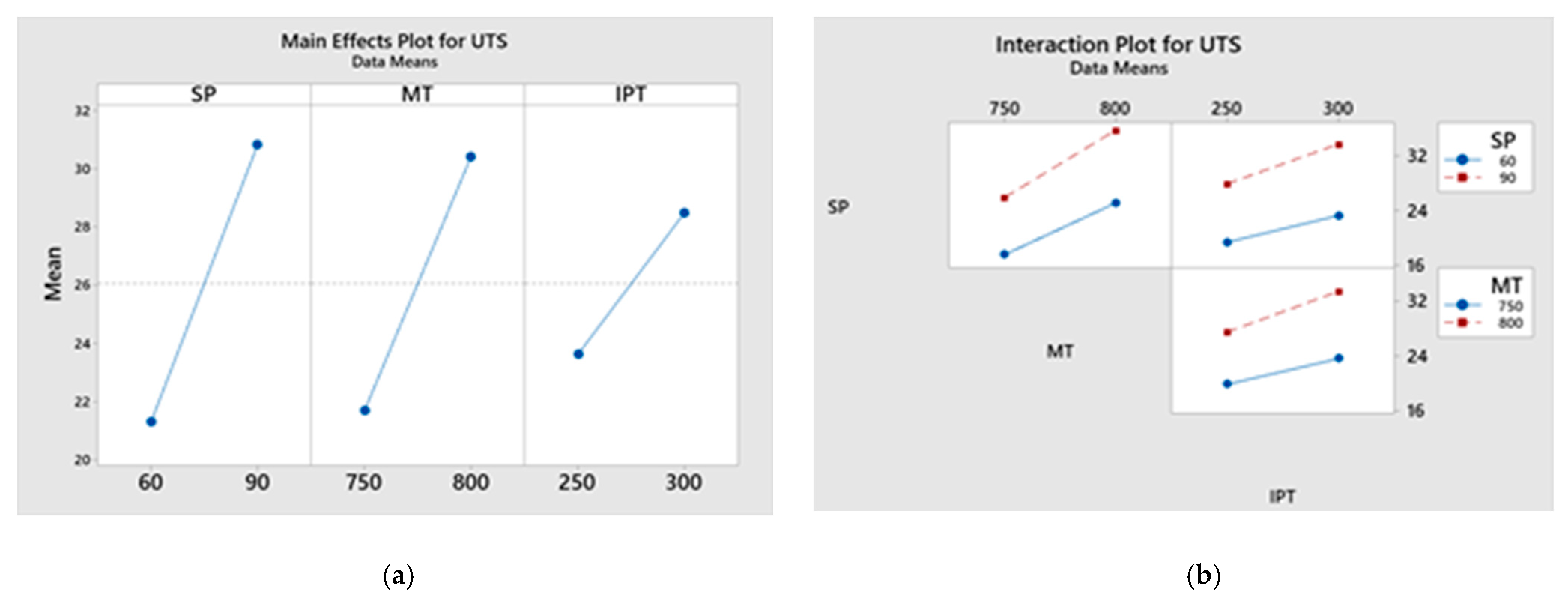Evaluating the Effect of Process Parameters on the Mechanical Properties of an AA7075-Cu Overcast Joint Using the Taguchi Method †
Abstract
:1. Introduction
2. Materials and Methods
3. Experiment Design
4. Results and Discussion
5. Validations
6. Conclusions
Author Contributions
Funding
Institutional Review Board Statement
Informed Consent Statement
Data Availability Statement
Conflicts of Interest
References
- Zhou, B.; Liu, B.; Zhang, S. The Advancement of 7xxx Series Aluminum Alloys for Aircraft Structures: A Review. Metals 2021, 11, 718. [Google Scholar] [CrossRef]
- Sajid, M.; Wasim, A.; Hussain, S.; Jahanzaib, M. Manufacturing feature-based cost estimation of cast parts. China Foundry 2018, 15, 464–469. [Google Scholar] [CrossRef]
- Ali, M.; Jahanzaib, M.; Wasim, A.; Hussain, S.; Anjum, N.A. Evaluating the Effects of As-Casted and Aged Overcasting of Al-Al Joints. Int. J. Adv. Manuf. Technol. 2018, 96, 1377–1392. [Google Scholar] [CrossRef]
- Ali, M.A.; Ishfaq, K.; Raza, M.H.; Farooq, M.U.; Mufti, N.A.; Pruncu, C.I. Mechanical Characterization of Aged AA2026-AA2026 Overcast Joints Fabricated by Squeeze Casting. Int. J. Adv. Manuf. Technol. 2020, 107, 3277–3297. [Google Scholar] [CrossRef]
- Liu, T.; Wang, Q.; Sui, Y.; Wang, Q.; Ding, W. An Investigation into Interface Formation and Mechanical Properties of Aluminum–Copper Bimetal by Squeeze Casting. Mater. Des. 2016, 89, 1137–1146. [Google Scholar] [CrossRef]
- Astm, C. Philadelphia: American Society for Testing Materials; ASTM Standards: West Conshohocken, PA, USA, 1958. [Google Scholar]


| Elements | Mg | Mn | Si | Fe | Cu | Ti | Zn | Cr | Al |
|---|---|---|---|---|---|---|---|---|---|
| Weight Percent (Al) | 2.1 | 0.3 | 0.4 | 0.5 | 1.2 | 0.2 | 5.1 | 0.18 | Remainder |
| Experiment No. | Input Variables | Output Response (UTS) | |||
|---|---|---|---|---|---|
| SP | MT | IPT | Mean | Standard Deviation | |
| 1 | 60 | 750 | 250 | 16.00 | 1.50 |
| 2 | 60 | 750 | 300 | 19.00 | 1.32 |
| 3 | 60 | 800 | 250 | 22.67 | 1.26 |
| 4 | 60 | 800 | 300 | 27.50 | 1.32 |
| 5 | 90 | 750 | 250 | 23.63 | 1.52 |
| 6 | 90 | 750 | 300 | 28.13 | 1.10 |
| 7 | 90 | 800 | 250 | 32.20 | 1.18 |
| 8 | 90 | 800 | 300 | 39.33 | 0.76 |
| Level | SP | MT | IPT |
|---|---|---|---|
| 1 | 21.29 | 21.69 | 23.63 |
| 2 | 30.83 | 30.43 | 28.49 |
| Delta | 9.53 | 8.73 | 4.87 |
| Rank | 1 | 2 | 3 |
| Source | DF. | Seq SS. | Adj SS. | Adj MS. | F | P | Contribution Ratios |
|---|---|---|---|---|---|---|---|
| SP | 1 | 181.769 | 181.769 | 181.769 | 103.51 | 0.001 | 0.48 |
| MT | 1 | 152.542 | 152.542 | 152.542 | 86.87 | 0.001 | 0.40 |
| IPT | 1 | 47.369 | 47.369 | 47.369 | 26.98 | 0.007 | 0.12 |
| Residual Error | 4 | 7.024 | 7.024 | 1.756 | |||
| Total | 7 | 388.704 |
| Actual Value | Predicted Value | Error | Percentage Error |
|---|---|---|---|
| 39.33 | 38.17 | 1.16 | 3.63 |
Publisher’s Note: MDPI stays neutral with regard to jurisdictional claims in published maps and institutional affiliations. |
© 2022 by the authors. Licensee MDPI, Basel, Switzerland. This article is an open access article distributed under the terms and conditions of the Creative Commons Attribution (CC BY) license (https://creativecommons.org/licenses/by/4.0/).
Share and Cite
Hanif, M.W.; Wasim, A.; Sajid, M. Evaluating the Effect of Process Parameters on the Mechanical Properties of an AA7075-Cu Overcast Joint Using the Taguchi Method. Eng. Proc. 2022, 23, 3. https://doi.org/10.3390/engproc2022023003
Hanif MW, Wasim A, Sajid M. Evaluating the Effect of Process Parameters on the Mechanical Properties of an AA7075-Cu Overcast Joint Using the Taguchi Method. Engineering Proceedings. 2022; 23(1):3. https://doi.org/10.3390/engproc2022023003
Chicago/Turabian StyleHanif, Muhammad Waqas, Ahmad Wasim, and Muhammad Sajid. 2022. "Evaluating the Effect of Process Parameters on the Mechanical Properties of an AA7075-Cu Overcast Joint Using the Taguchi Method" Engineering Proceedings 23, no. 1: 3. https://doi.org/10.3390/engproc2022023003







